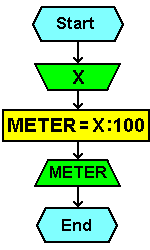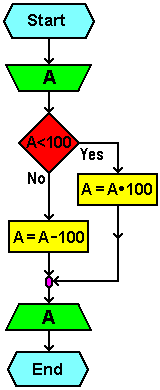Example IV |
Write an algorithm and flowchart for converting length expressed in units of measure 'centimeter' in the measuring unit 'meter'. Specifies the number of measuring in centimeters, and should determine how it meters.
Algorithm:
start ----------------------------------------------------- Input X METER = X / 100 Print METER ----------------------------------------------------- end
| Flowchart: | Program code: |
 |
CLS CLEAR INPUT X met = X / 100 PRINT met END |
Write an algorithm and flowchart which a given number A increased 100 times if A is less than 100, otherwise A is decreased by the 100. Print this result.
Algorithm:
start ----------------------------------------------------- Input A If A < 100 Then A = A × 100 Else A = A - 100 Print A ----------------------------------------------------- end
| Flowchart: | Program code: |
 |
CLS
CLEAR
INPUT A
IF A < 100 THEN
A = A * 100
ELSE
A = A - 100
END IF
PRINT A
END
|
Write an algorithm and flowchart for calculating the perimeter of the square, if the default length of the side of the square A. Before computation to check whether the side of the square is greater than 0, and if not print a message: 'Side of the square must be a positive number.'
Algorithm:
start ----------------------------------------------------------- Input A If A > 0 Then PERIMETER = 4 × A, print PERIMETER Else print 'Side of the square must be a positive number.' ----------------------------------------------------------- end
| Flowchart: | Program code: |
 |
CLS
CLEAR
INPUT A
IF A > 0 THEN
per = A * 4
PRINT "Perimeter=" per
ELSE
PRINT "Side of square must be"
PRINT "a positive number."
END IF
END
|
|
Citing of this page: Radic, Drago. " Informatics Alphabet " Split-Croatia. {Date of access}; https://informatics.buzdo.com/file. Copyright © by Drago Radic. All rights reserved. | Disclaimer |